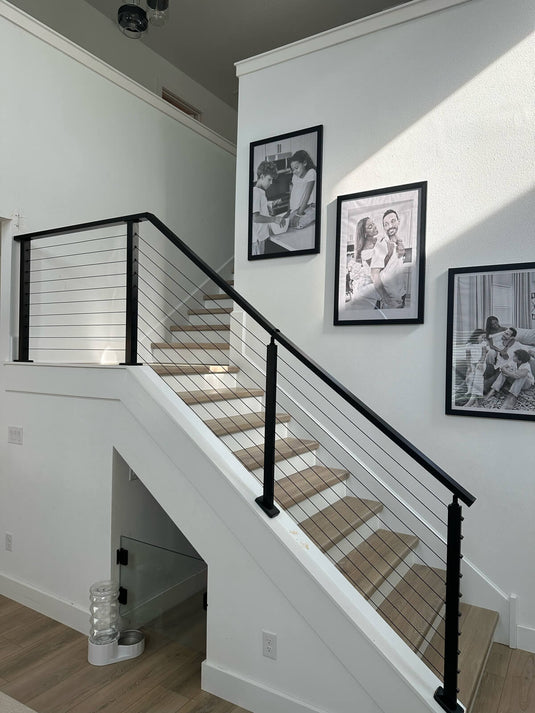TABLE OF CONTENTS
Glass Railing vs. Cable Railing: Which Is Right for Your Home
Introduction
When remodeling or building a new home, picking the right railing system is a big decision. Glass railings and cable railings are two popular, modern options. They add contemporary flair but vary in cost, installation, durability, maintenance, and best uses. Understanding the pros and cons of glass versus cable railings will help you choose the best fit for your home.

Cable vs. Glass Railing: Cost
Cost often drives railing selection. Cable railings tend to be more affordable than glass.
Cable railings need cables, tensioners, attachments, and mounts. Stainless steel cables resist corrosion and need minimal maintenance. Installed costs run $50-$100 per linear foot.
Glass railings utilize tempered or single-piece glass. Fabricating and installing glass is pricier than cables. Prices average $200-$300 per linear foot installed.
For tighter budgets, cable railings offer an attractive, lower-cost alternative to pricier glass.
Cable vs. Glass Railing: Installation
Installing cable and glass railings differs quite a bit. Cable installation simply involves running taut cables between posts and securing them with fittings. Glass installation requires carefully measuring and fitting tempered panels into top and bottom channels on the posts. The glass must be cut to exact specifications and firmly anchored.
The cable railing's modular design makes installation more DIY-friendly. Lightweight cable components are easily assembled on-site using basic tools. Homeowners with some mechanical ability can often install cables themselves. But heavy, delicate glass panels demand expertise to prevent breakage. Each panel must be positioned precisely and anchored - best left to experienced contractors.
For DIY installation, cables are an easier choice than glass systems requiring special handling.

Cable vs. Glass Railing: Durability
With proper installation, cable and glass railings endure for years with minimal wear. But their durability differs.
Stainless steel cable railings withstand outdoor elements like weather and ocean air. With periodic cleaning and re-tensioning, cables operate for 15-20 years or longer. Stainless steel resists gradual corrosion.
Quality tempered glass also survives weathering for 10-15 years before scratches show. But glass loses flexibility over time and can eventually crack from hard impacts, unlike when newer. Still, it keeps excellent longevity.
In short, cables and glass both provide lasting safety and aesthetics for over a decade. Cables may slightly outlast glass, but both deliver long-term performance.

Cable vs. Glass Railing: Maintenance
Maintenance is easier for cable versus glass railings, though both need periodic upkeep.
Cable railings should be inspected yearly and re-tensioned to account for stretching. Cables just need occasional light cleaning to prevent buildup and corrosion.
Glass railings require careful handling and cleaning. Check for loose fittings and seal deterioration around panels. Use specialty glass cleaners and soft cloths to keep surfaces pristine and smudge-free. Avoid harsh chemicals or abrasive pads.
So cable systems need less frequent maintenance than delicate glass necessitating cautious care.
Cable vs. Glass Railing: Best Uses
The ideal setting often dictates the better railing choice.
Cable Railings:
- Outdoor decks and patios - open views
- Rooftop spaces - lightweight, transparent look
- Contemporary interiors - modern industrial vibe
- Budget option - easier installation, lower cost
- DIY project - accessible for homeowners
Glass Railings:
- Indoor spaces - unobstructed views
- High-end contemporary homes - sleek transparency
- Pool areas - visibility through panels
- Higher floors/open sides of buildings - added safety
- Oceanfront - resists salt air
Analysis shows cables excel in outdoor settings, while glass maximizes indoor visibility near unobstructed edges.
Cable Railing vs. Glass Railing: Aesthetics
The visual appearance and design aesthetic also differ between cable railings and glass railings. This aesthetic factor often impacts which style homeowners choose for their spaces.
Cable railings have a very light and open look. The thin stainless-steel cables seem to disappear, only visible when looking closely. This creates an unobstructed view beyond the railing since there are no solid panels. The modern cable style works well in contemporary spaces, adding an industrial touch. Glass panels produce some visual obstruction, although the transparency maintains most of the view. The sleek glass look also fits contemporary home styling. For indoor spaces, glass railings protect views while mimicking openness.
In terms of customization, cable systems remain fairly minimalist but offer some flexibility with cable spacing and post styles. Glass railings can incorporate custom etched designs, color tints, lighting, and different post styles for a more personalized look.
Overall, cable railings excel at providing an unimpeded view with their barely visible cables, while glass makes a bold style statement with transparent panels. Depending on the desired aesthetic, either material can suit modern and contemporary home spaces.
Cable vs. Glass Railing: Which Is Better for My Home?
Choosing cable or glass railings depends on your budget, location, style preferences, and maintenance comfort level.
For DIYers on a budget seeking outdoor railings, cable systems often make the most sense. The reasonable cost, easy installation, durability, and low-maintenance make cables ideal for decks, patios, or rooftops without blocking views.
However, if you can invest more for uninterrupted indoor or oceanfront views and modern styling, glass warrants the higher price. It’s wise to hire a qualified installer to properly measure, cut, and secure the heavy panels—ensuring safety while maximizing visibility and sleek aesthetics. Though durable, glass needs careful cleaning but withstands oceanfront conditions. Custom etchings can further personalize glass.
Carefully weighing the pros and cons around budget, installation, lifespan, appearance, and maintenance here will help identify the right railing material for your needs. Consider how these factors fit with your specific budget, project scope, design vision, and location to make the optimal cable vs. glass decision for your space. Keeping the key differences in mind allows for the railings that complement your home’s aesthetics and functions.
Conclusion
You now understand the meaningful cable vs. glass railing differences. Glass provides maximum visibility but requires professional installation. For budget-conscious DIYers, cables are a more affordable, easier outdoor option. Use this comparison to evaluate costs, benefits, and uses to select the railings suiting your home's style and needs. With these insights, you can make an informed choice on the best system to enhance your living spaces.




